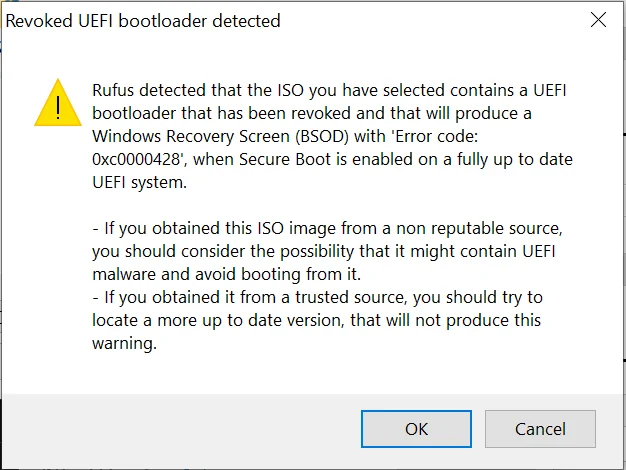1. Introduction Rufus, a widely-used tool for creating bootable USB drives, has recently been displaying a warning labeled ‘Error 0x0000428’. While this might seem alarming, it’s essential to understand the context and implications of this message.
2. Background: The UEFI Bootloader The Unified Extensible Firmware Interface (UEFI) is a specification that defines a software interface between an operating system and platform firmware. It plays a crucial role in booting up our systems securely. Bootloaders, on the other hand, are essential components that load the operating system into the computer’s memory.
3. The Black Lotus Secure Boot Vulnerability Before May 2023, almost all Microsoft Windows UEFI bootloaders were vulnerable to the Black Lotus Secure Boot vulnerability. As a result, Microsoft is in the process of revoking these bootloaders. If they stick to their timeline, all affected bootloaders should be revoked by Q1 2024.

4. Understanding the ‘Error 0x0000428’ in Rufus Contrary to what the message might suggest, this is not an actual error. It’s a warning. Rufus is alerting users that booting media using these vulnerable bootloaders could be risky, especially if the Windows image source isn’t trustworthy. If your UEFI system has been updated to block these bootloaders, that’s when you might see the ‘Error 0x0000428’. It’s worth noting that this isn’t an error Rufus has encountered, but one you might face when trying to boot the media.
5. Solutions and Workarounds
- Verify Your Windows Image Source: Ensure that you’re obtaining your Windows image from a reliable and official source.
- Update Your UEFI System: Regular updates can prevent these vulnerable bootloaders from running.
- Use Trusted Sources: Always use trusted sources when creating bootable drives.
- Other Tools: Consider other reputable tools for creating bootable drives if you’re concerned about this warning.
6. Best Practices for Secure Booting
- Stay Updated: Regularly update your systems and software.
- Check for Bootloader and Firmware Updates: Ensure that your bootloaders and firmware are up-to-date.
- Avoid Untrusted Downloads: Always download software and images from official or trusted sources.
7. Conclusion While the ‘Error 0x0000428’ might seem concerning, understanding its context and following best practices can ensure a secure booting experience. Rufus’s warning serves as a reminder to prioritize security in our digital activities.
8. Additional Resources For those interested in a deeper dive into why Rufus introduced this alert, you can explore the discussion on Rufus’s official GitHub page. However, be prepared; the revocation procedure details can be a bit intricate.

